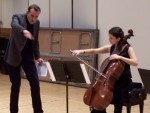Title
On November 15, cellists Kimberly Patterson, Saeunn Thorsteinsdottir, Hugh Lesure, and I had the great privilege of performing for Martin Lohr, one of the Berlin Philharmonic’s preeminent solo cellists and a Juilliard alumnus. The four of us presented standard excerpts by Rossini, Brahms, and Tchaikovsky from Juilliard’s principal cello audition list. From the outset, Mr. Lohr’s views on playing excerpts in an audition setting were very strong and abundantly clear.
Body
As young cellists new to the audition process, we sometimes feel that we must acquire the right fingerings and imitate the sound of the orchestra for which we are auditioning in order to win the chair. Mr. Lohr’s audition philosophy is vastly different. Although he gave excellent and useful fingering suggestions, he backed up each idea with the insistence that “fingerings are only tools you use to ultimately tell a story or convey a different character when you play”—in other words, a means to an end. One must always focus on what is to be conveyed in order to become a great cellist, and more importantly, a great musician.
Each student performed several excerpts, though there is only room here to touch on one that seemed a highlight for each performer, in which Mr. Lohr made the most significant contribution to the student.
First-year master’s student Kimberly Patterson provided a very thoughtful and musical reading of the cello solo in Rossini’s William Tell Overture. Mr. Lohr responded by asking for a more “free” interpretation of the excerpt. After experimenting with different bow articulations and some character changes, he asked her to play the same excerpt againthis time, as if she had no idea what was coming next. The resulting change was fresh and impressive, and certainly attention-grabbing for the audience.
Mr. Lohr focused on the importance of bow weight and sound colors with second-year master’s student Saeunn Thorsteinsdottir, who presented a solid interpretation of the opening theme from the second movement of Brahms’s Second Symphony. Capitalizing on her strengths, Mr. Lohr stressed the significance of reaching for a very deep but open sound to allow the phrase to sing. He experimented with having the weight of the bow on the string come from her back rather than the arm, and as a result, Saeunn spun a much more resonant and open tone.
Fourth-year undergraduate Hugh Lesure performed the second theme from the first movement of Brahms’s Second Symphony with substantial authority. Mr. Lohr concentrated on Hugh’s bow hand, in order to release the tension in his fingers. A relaxed hand gave him increased ability to execute the staccato octave jumps with great precision. Next, Mr. Lohr worked on maintaining this relaxation while Hugh was playing the excerpt itself. A much more perceptible and solid internal rhythm was then evident.
As the final performer, I felt Mr. Lohr was most helpful with my performance of the cello solo from Brahms’s Second Piano Concerto. He felt the characters and sounds I was trying to produce would have been better communicated to the audience if I had “opened my body.” By not hunching over my instrument, I found a more efficient way to obtain the desired “open” sound. With the posture of my shoulders and upper chest corrected, it was much easier to vary my vibrato and experiment with many more colors in the excerpt.
Mr. Lohr showed us all the importance of bow articulations and weight, colors, posture/relaxation, and most importantly, character contrast in communicating to the audience. During the question-and-answer session, he briskly answered the question of whether it was a good strategy to play the bowings and mimic the sound of the orchestra for which you are auditioning in order to gain an advantage in the process. “If you play with no character, I think you might become a good cellist,” he said. “But when you have something to say, I think, ‘Wow! There is a great cellist and a great musician.’” Behind the audition curtain, it seems that character is what separates the true artists from the merely capable.





